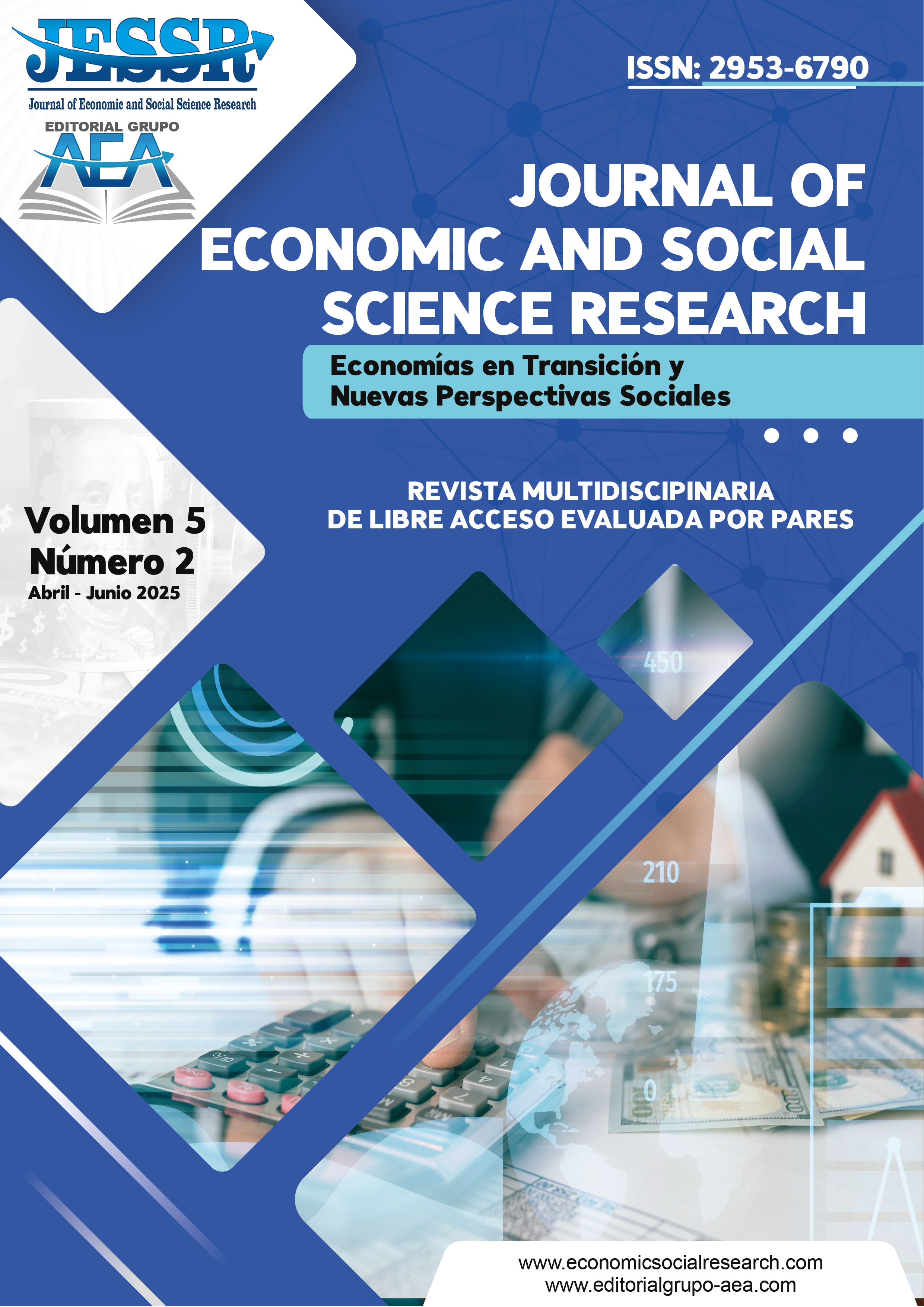Environmental assessment of agricultural and forestry systems by population analysis of nematodes as bioindicators
Main Article Content
Abstract
Growing concern about the degradation of agricultural and forest soils has prompted the use of bioindicators to assess their quality and health. This study evaluated the population structure of free-living nematodes associated with cocoa and teak production systems in two locations (Quevedo and El Empalme). Rhizospheric soil sampling was carried out, extracting nematodes by centrifugation and sugar flotation techniques, and then classifying individuals into trophic groups and calculating maturity, diversity and structure indices. The results showed a high abundance of phytoparasitic genera, especially Meloidogyne, and the presence of beneficial genera such as Mononchus and Dorylaimus. Differences in diversity and maturity indices were observed among localities, reflecting variations in soil quality associated with land use systems, the higher representation of opportunistic genera in certain systems suggests a degree of environmental disturbance related to management practices, it can be concluded that the analysis of nematode populations provides accurate and relevant information for the diagnosis of soil health in agroecosystems and tropical forest ecosystems.
Downloads
Article Details
Section

This work is licensed under a Creative Commons Attribution-NonCommercial 4.0 International License.
How to Cite
References
Azpilicueta, C. V., & Aruani, M. C. (2016). Nematodos:¿ qué beneficios aportan al suelo?. Experticia. Facultad de Ciencias Agrarias–Universidad Nacional de Cuyo, (5). https://bdigital.uncu.edu.ar/objetos_digitales/18537/14-azpilicueta-claudia-viviana-y-aruani-mara-cristina..pdf
Bongers, T. (1985). Dutch forest nematodes. Nematologica, 31(3), 356–357. https://doi.org/10.1163/187529285X00436 DOI: https://doi.org/10.1163/187529285X00436
Bongers, T., & Bongers, M. (1998). Functional diversity of nematodes. Applied Soil Ecology, 10(3), 239–251. https://doi.org/10.1016/S0929-1393(98)00123-1 DOI: https://doi.org/10.1016/S0929-1393(98)00123-1
Castilla-Díaz, E. E., Millán-Romero, E., Mercado-Ordoñez, J., & Millán-Páramo, C. (2017). Relación de parámetros edáficos sobre la diversidad y distribución espacial de nematodos de vida libre. Revista Tecnología en Marcha, 30(3), 24–34. https://doi.org/10.18845/tm.v30i3.3270 DOI: https://doi.org/10.18845/tm.v30i3.3270
Crozzoli, R. (2002). Especies de nematodos fitoparasíticos en Venezuela. Interciencia, 27(7), 354–364. https://www.redalyc.org/pdf/339/33907004.pdf
Diago, O. (2013). Metodologías dialógicas para el fortalecimiento etnoeducativo y la conservación ambiental entre pueblos ancestrales caucanos en procesos de resistencia. El diálogo de saberes, 85, 1–20. https://www.researchgate.net/publication/340310256_Metodologias_dialogicas_para_el_fortalecimiento_etnoeducativo_y_la_conservacion_ambiental_entre_pueblos_ancestrales_caucanos_en_procesos_de_resistencia_85
Ferris, H., Griffiths, B. S., Porazinska, D. L., Powers, T. O., Wang, K.-H., & Tenuta, M. (2014). Reflections on plant and soil nematode ecology: Past, present and future. Journal of Nematology, 44(2), 115–126. https://pubmed.ncbi.nlm.nih.gov/23482864/
Hernández, A. E. (2013). Nematodos como indicadores ambientales [Material didáctico]. Universidad Nacional de Costa Rica (UNA). https://repositorio.una.ac.cr/items/7aa2ebd0-2b20-44eb-9345-148357a86d9c
Leguízamo, M. C., & Parada, J. C. (2008). Nematodos del suelo en el sistema maíz–soya y en hábitats naturales adyacentes de la Altillanura colombiana (Meta). Ciencia y Tecnología Agropecuaria, 9(1), 61–65. https://revistacta.agrosavia.co/index.php/revista/article/view/105 DOI: https://doi.org/10.21930/rcta.vol9_num1_art:105
Luc, M., Sikora, R. A., & Bridge, J. (2005). Plant parasitic nematodes in subtropical and tropical agriculture (2.ª ed., pp. 1–871). CABI Publishing. https://horizon.documentation.ird.fr/exl-doc/pleins_textes/2021-09/34395.pdf DOI: https://doi.org/10.1079/9780851997278.0000
Magurran, A. E. (1988). Diversity indices and species abundance models. In Ecological diversity and its measurement (pp. 7–45). Princeton University Press. https://link.springer.com/book/10.1007/978-94-015-7358-0 DOI: https://doi.org/10.1007/978-94-015-7358-0_2
Molina, E. L. M. (2011). Biodiversidad de nematodos en suelos de ambientes cultivados, ecotono y bosque prístino y su potencial para controlar chisas (Coleoptera: Melolonthidae) [Tesis doctoral, Escuela Politécnica del Ejército].
Moreno, C. E. (2010). Métodos para medir la biodiversidad (Vol. 1). Manuales y tesis SEA.
Riches, J. R., Read, R. W., Black, R. M., Cooper, N. J., & Timperley, C. M. (2012). Analysis of clothing and urine from Moscow theatre siege casualties reveals carfentanil and remifentanil use. Journal of Analytical Toxicology, 36(9), 647–656. https://doi.org/10.1093/jat/bks078 DOI: https://doi.org/10.1093/jat/bks078
Romero, E. M., Castilla Díaz, E. E., & Millán Páramo, C. (2016). Comunidades de nematodos de vida libre del suelo y su correspondencia con la calidad. Ingeniería y Región, 16, 25–34. https://doi.org/10.25054/22161325.1282 DOI: https://doi.org/10.25054/22161325.1282
Sánchez-Moreno, S., & Talavera, M. (2013). Los nematodos como indicadores ambientales en agroecosistemas. Ecosistemas, 22(1), 50–55. https://rua.ua.es/dspace/handle/10045/28126
Varela-Benavides, I. (2014). Las comunidades de nematodos como indicadores ambientales. Revista Tecnología en Marcha, 27(30), 1–12. https://doi.org/10.18845/tm.v0i0.1653 DOI: https://doi.org/10.18845/tm.v0i0.1653
Yeates, G. W., & Boag, B. (2016). Female size shows similar trends in all clades of the Phylum Nematoda. Nematology, 8, 111–127. https://doi.org/10.1016/S0167-8809(99)00033-X DOI: https://doi.org/10.1163/156854106776179881
Yeates, G. W., & Bongers, T. (1999). Nematode diversity in agroecosystems. In G. W. Barrett & T. L. Barrett (Eds.), Invertebrate biodiversity as bioindicators of sustainable landscapes (pp. 113–135). https://doi.org/10.1016/B978-0-444-50019-9.50010-8 DOI: https://doi.org/10.1016/B978-0-444-50019-9.50010-8





